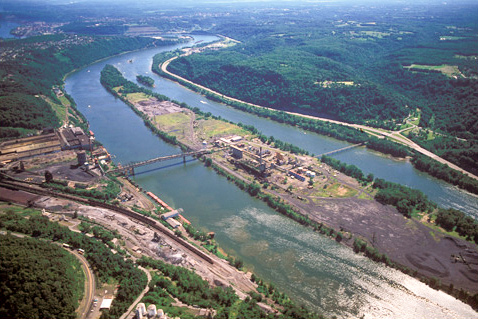They had planned to be underway at sunrise, but 5 September 1803 opened on another foggy dawn, the third of six in a row. “Loaded both my canoes and waited till the fogg disappeared,” Lewis wrote; they finally shoved off at eight. Thomas Jefferson, who himself systematically recorded daily weather observations for more than fifty years, wherever he happened to be, had directed Lewis to observe “climate as characterized by the thermometer, by the proportion of rainy, cloudy & clear days, by lightening, hail, snow, ice, by the access of frost, [and] by the winds prevailing at different seasons.” He didn’t mention fog, but Lewis was suitably inspired by the spirit of observation and inquiry, and couldn’t resist speculating on the reason for the phenomenon that would delay their departures on a great many of the hundreds of days they were to be on rivers, smothered under fogbanks while the skies on either side were clear.
He may have thought it through before, or perhaps had gotten the explanation from someone else, but in any case his journal entry for 1 September 1803, when they couldn’t see 40 paces ahead, seems to reflect his own deliberation:
these Foggs are very common on the Ohio at this season of the year as also in the spring but do not think them as freequent or thick in the spring. perhaps this may in some measure assist us to account for the heavy dues [dews] which are mor remarkable for their freequency and quantity than in any country I was ever in– they are so heavy the drops falling from the trees from about midknight untill sunrise gives you the eydea of a constant gentle rain, this continues untill the sun has acquired sufficient altitude to dessipate the fogg by it’s influence, and then it ceases. the dues are likewise more heavy during summer than elsewhere but not so much so as at this season.—
the Fog appears to owe it’s orrigin to the difference of temperature between the air and water the latter at this seson being much warmer than the former; the water being heated by the summer’s sun dose not undergo so rapid a change from the absence of the sun as the air dose consiquently when the air becomes most cool which is about sunrise the fogg is thickest and appears to rise from the face of the water like the steem from boiling water–
Beginning on the second foggy dawn he recorded the temperature differential between the river and the air above it, ranging from as little as 2° to as much as 21°, with the air cooler than the water.
They camped for that night somewhere on the big island in Jim’s photograph, now known as Brown’s. When darkness fell the two canoes, which carried most of Lewis’s most valuable supplies, were still behind. “Ordered the trumpet to be sound[ed],” he wrote, “and they came up in a few minutes.” That “trumpet” was not a musical instrument but a small, loud, one-note horn of the type widely used then by boatmen for signaling. On the expedition, the four horns Lewis had purchased in Philadelphia would be useful, as in this instance, for keeping the boats in touch with one another on the broad expanses of the Missouri River, and for calling in overdue hunters.
First settled in 1765, Steubenville—Lewis wrestled with the spelling and came up with “Steuwbenville”—was from 1786 until 1790 the site of a frontier fortification named for Frederick William Augustus, Baron von Steuben, the Prussian officer who was the chief drillmaster for the American Colonial army. His drill manual was still the sole guidebook for the army of 1803.
Weirton, West Virginia, out of the picture at right, wasn’t yet on the map when Lewis passed by. A steel-maker named Ernest Weir built a mill there in 1909, which became the life-blood of a group of unincorporated communities that merged into the town of Weirton in 1947. It has been an employee-owned industry since the early 1980s. Elsewhere in the valley, idle machines, cold hearths, and empty rail yards are mostly monuments to what once was one of the leading steel-producing areas in the U.S.
From Discovering Lewis & Clark from the Air
Photography by Jim Wark
Text by Joseph Mussulman
Reproduced by permission of Mountain Press
Experience the Lewis and Clark Trail
The Lewis and Clark Trail Experience—our sister site at lewisandclark.travel—connects the world to people and places on the Lewis and Clark Trail.
Discover More
- The Lewis and Clark Expedition: Day by Day by Gary E. Moulton (University of Nebraska Press, 2018). The story in prose, 14 May 1804–23 September 1806.
- The Lewis and Clark Journals: An American Epic of Discovery (abridged) by Gary E. Moulton (University of Nebraska Press, 2003). Selected journal excerpts, 14 May 1804–23 September 1806.
- The Lewis and Clark Journals. by Gary E. Moulton (University of Nebraska Press, 1983–2001). The complete story in 13 volumes.


